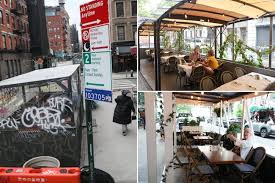
Table of Contents
In New York City, a wave of outdoor dining sheds is facing closure as a result of newly enforced regulations aimed at addressing public safety and urban aesthetics. The new rules, which target issues related to storage, tree placement, and access to fire hydrants, have led many restaurants to shutter their outdoor dining structures, citing prohibitive costs and logistical challenges. This development reflects the city’s ongoing struggle to balance vibrant street life with regulatory compliance and safety concerns.
Background of the Outdoor Dining Program
The outdoor dining sheds, or “streeteries,” emerged as a temporary measure during the COVID-19 pandemic to help restaurants survive during periods of restricted indoor dining. The program, initially intended to provide a lifeline to struggling eateries, allowed restaurants to expand their seating onto sidewalks and streets, creating a more vibrant and socially distant dining environment.
Throughout the pandemic, these outdoor structures became a hallmark of New York City’s recovery effort, contributing to the bustling street life that many residents and visitors enjoyed. However, as the pandemic waned, the city began reassessing the long-term viability and safety of these installations.
New Regulations and Their Impact
The recently introduced regulations are part of the city’s efforts to standardize and regulate the outdoor dining setups, ensuring they align with broader urban planning and safety objectives.
- Storage Requirements: Restaurants are now required to store outdoor furniture and other materials in designated areas when the dining sheds are not in use. This regulation aims to prevent clutter and maintain clear, unobstructed sidewalks.
- Tree Planting and Maintenance: The new rules mandate that outdoor dining structures must be situated in a way that preserves the city’s trees and allows for their proper maintenance. This is intended to protect the urban green spaces that contribute to the city’s aesthetics and environmental health.
- Fire Hydrant Access: Ensuring that fire hydrants remain accessible is a critical safety measure. The new regulations stipulate specific distances that dining sheds must maintain from fire hydrants, enhancing emergency response capabilities in case of a fire.
These regulations, while aimed at improving safety and urban design, have had a significant impact on many restaurant owners. The costs associated with compliance, such as redesigning the sheds, relocating furniture, and making structural adjustments, have proven to be prohibitively high for some establishments.
Financial and Operational Challenges
For many restaurants, the financial burden of adapting to the new regulations has been a major factor in their decision to close their outdoor dining sheds. Compliance with the new rules often involves significant costs, including:
- Redesign and Reconstruction: Restaurants may need to overhaul their existing dining sheds to meet new standards, which can be expensive. Costs include architectural redesigns, construction, and potential renovations.
- Operational Costs: The requirement for designated storage spaces and regular maintenance to meet the new guidelines adds to the operational expenses of running an outdoor dining setup. For many small and medium-sized restaurants, these costs are unsustainable.
- Lost Revenue: Shuttering outdoor dining sheds can lead to a reduction in seating capacity, which impacts revenue. Restaurants that relied heavily on outdoor dining to maintain profitability during the pandemic may find it difficult to make up for the lost income.
These financial challenges have led numerous restaurant owners to conclude that the costs of compliance outweigh the benefits. As a result, many have decided to dismantle their outdoor dining sheds, further exacerbating the difficulties faced by the hospitality industry.
Public and Community Reactions
The closure of outdoor dining sheds has elicited mixed reactions from the public and community stakeholders. On one hand, some residents and business owners have expressed support for the new regulations, arguing that they contribute to a safer and more orderly urban environment. The preservation of tree-lined streets and unobstructed access to fire hydrants are seen as important for maintaining the city’s infrastructure and aesthetics.
Community advocates and restaurant owners have called for a more balanced approach that considers the financial realities faced by small businesses. They argue that the city should provide additional support or financial assistance to help restaurants comply with the new regulations without forcing them to close their outdoor dining areas.
City Response and Future Outlook
In response to the concerns raised by restaurant owners and community members, city officials have indicated a willingness to review and potentially adjust the regulations. There is ongoing dialogue between the city government, business associations, and community groups to address the issues and find a workable solution.
Potential adjustments could include:
- Financial Assistance: Providing grants or subsidies to help restaurants with the costs of compliance could ease the financial burden and support the continued operation of outdoor dining setups.
- Flexible Guidelines: Revising the regulations to allow for more flexibility in design and placement might help restaurants meet safety and aesthetic requirements without incurring excessive costs.
As the city navigates these challenges, the goal will be to strike a balance between maintaining safety and public order while supporting the vitality of local businesses. The outcome of these discussions will likely shape the future of outdoor dining in New York City and influence how other urban areas address similar issues.
Conclusion
The widespread shuttering of outdoor dining sheds in New York City, prompted by new regulations on storage, tree preservation, and fire hydrant access, highlights the complex interplay between urban regulation and business viability. While the regulations are intended to enhance safety and maintain the city’s aesthetic values, they have imposed significant financial and operational challenges on many restaurants.
As the city grapples with these issues, the need for a balanced approach that supports both public safety and economic vitality is crucial. The ongoing discussions and potential adjustments to the regulations will be key in determining how New York City adapts its outdoor dining landscape in the future, ensuring that it continues to thrive as a dynamic and inclusive urban environment.







